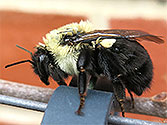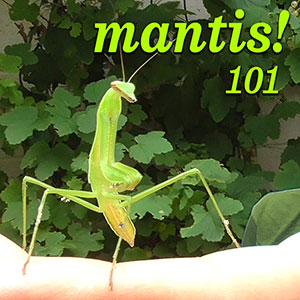Organic Pest Management & Beneficial Insect Controls
Each season, our gardens offer an ever changing variety of fruits and vegetables. Along with this, comes a variety of insecticidal pests. Nothing can take the wind out of your gardening sails faster than damage caused by these silent foes. In response, some gardeners won't hesitate to grab the first full spectrum insecticide they can find.
Then there's the organic approach which has gained in popularity. How can you fight off garden pests without using toxic pesticides or sprays? How can you attract & identify beneficial insects to help as natural controls? The more you rely on natural mechanisms, the less you'll need to personally do as a gardener.
- How to Manage Garden Pests Naturally:
- Destructive Insects (Garden Pests) Identification
- How to Protect Plants From Destructive Insects
- Why Healthy Plants Can Resist Pests
- How To Protect Plants With Physical Barriers
- How Companion Planting Protects Plants
- What Types of Organic Sprays Are Safe for Gardening?
- Identifying Beneficial Insects for Pest Control
- How to Attract Beneficial Insects to the Garden
Destructive Insects (Garden Pests) Identification
Our gardens serve as an oasis for life. With each type of crop you plant, you'll soon come to discover an insect or critter that has found a veritable feast. If left unchecked you can kiss your harvest good-bye. So take the time to recognize your enemies & what they're drawn to. Take the cabbage moth larvea, for example. Holes in my kale.... hmm? If you don't spot them fast, your leaves will be denuded.
How to Protect Plants From Destructive Insects
Why Healthy Plants Can Resist Pests
HEALTHY PLANTS ARE MORE RESILIENT: Without a doubt, preventing a pest infestation is the best option. Healthy plants are the first place to start. When humans feel sick, they try to get good rest, fluids & nourishment. By doing so, they can often fight off infections on their own. To an extent, the same applies to our plants. Drought stressed plants will wilt and could suffer tissue damage. Poorly fertilized vegetables will show obvious signs of deficiency. A plant that is starved for light will be thin and spindly. It won't have the energy to withstand attacks.
When our garden vegetables are under constant stress, many insects can naturally detect this. They often target and feast upon those weakened plants. Meanwhile, they may completely ignore the healthy ones that are just a few inches away! Aphids, pill bugs and maggots quickly come to mind. So keep your veggies healthy. Make sure they get proper light, moisture & nutrients. You can even select plant cultivars that have natural resistance to certain diseases, giving them a genetic advantage!
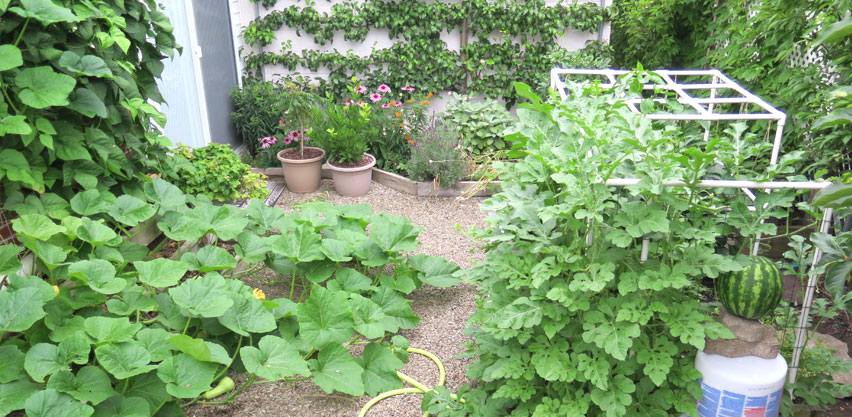
Supply plants with enough light, water & nutrients so they grow large & vigorous. Healthy plants can fight off pests & diseases.
How To Protect Plants With Physical Barriers
PHYSICAL BARRIERS TO PROTECT PLANTS: Even the most vigorous of plants can be overcome by the right pests. So you must be prepared to take accountability. They're counting on you! Screens and nettings can be constructed to protect leafy veggies. A physical barrier works great for keeping flies (and leaf mining maggots) off of your spinach and swiss chard. I've used anti-insect greenhouse netting with amazing success when protecting my kale from cabbage moths and their destructive worms.
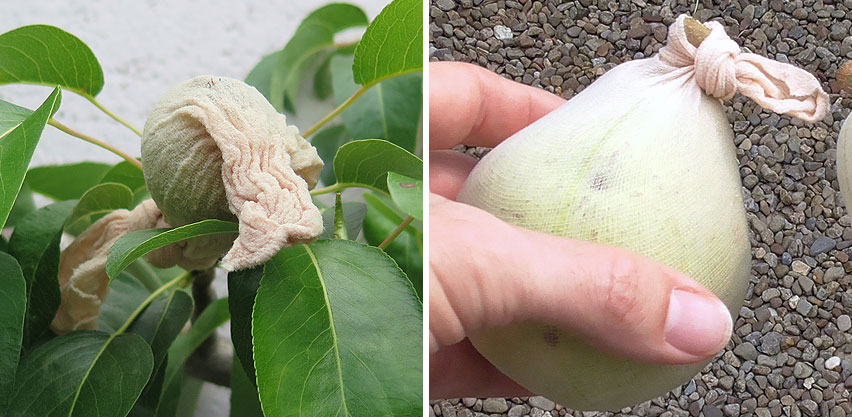
This organic nylon fruit maggot barrier can be tied around fruits when they're young to control pests.
ORGANIC POWDER COATINGS: You can even dust your crops with food grade diatomaceous earth to keep away mites and aphids. Diatomaceous earth comes from the fossilized remains of diatoms which act like tiny shards of glass. As long as you don't inhale it, it's not dangerous to humans. But it can kill pests that have an exoskeleton through desiccation. Kaolin clay is another option for organic gardeners. The mineral powder can be suspended in water and sprayed on plants. The remaining residue creates a particle film which can deter pests. It can be applied to fruits like apples and pears. Then after harvesting it is easy to wash off.

This insect netting is fine enough to even block out aphids, but it also excludes predators like this young praying mantis.
THE DOWNSIDE OF NETTING BARRIERS: Netting barriers are not a silver bullet though. Obviously, there's the upfront cost and installation time. Beyond that though, an insect netting doubles as a shade cloth. This is good in areas that are excessively hot and closer to the equator. But reduced light transmission can reduce yield in areas that already have marginal light exposure. Additionally, netting can keep out bad bugs, but also the good ones. That means you can't count on wasps, ladybugs or mantises to eliminate any pests that sneak through your defenses. You also won't get help from bees or other pollinators. So be sure to weigh the pros and cons when considering pest barriers.
How Companion Planting Protects Plants
COMPANION HERB PLANTING: The inclusion of companion herbs and flowers is a win-win for any gardener. Herbs can be harvested for consumption. Their flowers enhance the beauty of your garden. The fragrances can be delightful. And to top it all off, those very same fragrances that we may love, are HATED by some of our enemies!
Essential oils or volatile oils can be found in thousands of plants across the planet. These oils may contain phenolic compounds which can provide natural defense against harmful insect pests. Exposure to essential oils is often toxic or even lethal. Naturally then susceptible insects tend to stay away.
So why not use that to your advantage? Some gardeners have found garlic to deter Aphids, Cabbage Moth, Japanese Beetles, Tomato Worm or Weevils. Marigolds may help with Asparagus Beetles, Bean Beetles, Nematodes and Whiteflies. You might try lavendar for Fleas, Ticks, Mice or Moths. Basil, Chives, Mint, Oregano, Parsley, Rosemary and Tansy all help to create a defensive wall that will discourage many pests from even approaching.
What Types of Organic Sprays Are Safe for Gardening?
INSECTICIDAL SOAP: Once insect pests break through plant defenses, quick action may be needed. An application of a safe, organic, insecticidal soap will go a long way. Entire colonies can be wiped out with a single application, thereby turning the tides of war in your favor. Insecticidal soap can quickly wipe out an aphid colony, allowing your plants to recover. Insecticidal soap is completely organic and OMRI listed. It uses potassium salts of fatty acids to kill various soft-bodied insect pests like aphids, mealybugs, whiteflies, leafhoppers and mites. The spray is safe enough to be used up until the day of harvest.

Stressed plants brought indoors might harbor pests that require some sort of spray treatment.
NEEM OIL SPRAYS: Neem is also an excellent natural pesticide that works well for organic gardening. You can buy a concentrated form of neem which can be mixed to make a large volume of solution. Neem oil is derived from the seeds of the neem tree.
Not only can neem protect against insect pests, but even some pathogen diseases like powdery mildew, rust and black spot. It works well as a dormant spray for perennial garden plants. Neem does have a strong smell after it's first applied. And it leaves a protective shiny coating on plant leaves. For that reason, I don't apply it to greens that I intend to eat like spinach, lettuce, chard, kale, etc.
Video: Praying Mantis for Stink Bug &
Spotted Lanternfly Pest Control
Praying mantises are natural insect predators for controlling stink bug & spotted lanternfly pests!
Beneficial Insects for Organic Pest Control
"Beneficials" can include insects, arachnids, amphibians and more. Every day they're out there, in your garden -catching stink bugs, munching on aphids and decimating mites. When you come across a new insect you've never seen, you might not know if it's good or bad for the garden. It's true, if you're not careful you might encounter a little friendly fire. But typically, these guys are on YOUR side. So get out there and...
It's good to know that you're not alone in this battle. ENTER PREDATOR! That's right. Not every creepy-crawly is out to get you. Do you know what the larval form of a lady bug looks like? Well you should!!! Those little guys can do a lot to help you with your aphid problem. So when you spot one, please resist the urge to squish.
How to Attract Beneficial Insects to the Garden
How Pesticides Damage Beneficial Insects
PESTICIDES: ARE YOU KILLING YOUR FRIENDS? Broad spectrum insecticides, whether organic or not, can indiscriminately kill the good along with the bad. For example, neonic insecticides work systemically, penetrating all of a plant's tissues. Not only will these neurotoxins kill insects that feed on them, but even pollinators that consume the pollen and nectar of host plants.
In trying to thwart some unrelenting garden pest, we may be stamping out the biologic controls that would gladly do the work for us. So limit the use of pesticides and instead, focus on attracting the good bugs. Insecticidal soaps and neem oils are less destructive options, when push comes to shove.
ARE YOU KILLING OFF A FOOD SUPPLY? There's a second, less obvious, way that pesticides can negatively impact beneficial insects. Predatory insects like praying mantises or ladybugs actually require insect pests as a food source. Any time I've seen a runaway population of aphids, the lady bug nymphs were soon to follow. It takes a little patience, but nature tends to catch up and balance things out. By wiping out all insect pests with a spray, you might be careful not to directly damage beneficials. But you're still removing a vital food source which would have bolstered the ranks of those coveted predators. So just keep that in mind when determining whether a pesticide is really called for.
How To Create Habitat For Beneficial Insects

By cultivating a broad range of perennial flowers & herbs, beneficial insects have habitat to live, feed & reproduce.
VACANCY: CREATING AN INVITING HABITAT. In an urban setting, our yards may consist of grass, concrete, grass, asphalt and... grass. Where are the ladybugs expected to hang out all day? What cover is available for their developing larvae? Do you want to attract pollinators? Do you want predators like preying mantids to make camp for the summer? Then step outside of your garden and spend time looking at your landscape too. Select some bee friendly perennial flowers. Put in some herbs that will beautify your property while providing a home for beneficial insects. Lush, high density plantings of perennials paired alongside your traditional garden annuals will support a robust, healthy community. Year after year you will notice the ranks growing as balance is achieved in your little backyard ecosystem.
Buying Insects For Organic Pest Control
IMMIGRATION: BOLSTERING THE RANKS. Impatience can sometimes get the better of us. We may want to see predators NOW, rather than waiting five years to see our first resident green lacewing. If you don't mind spending a few bucks, there is always the option of ordering beneficial bugs online. Lady bugs, preying mantids, parasitic wasps and predatory mites can all be introduced to try to restore order in your garden. Some feel this is a waste. After all, many of these guys will just fly away, abandoning your prized tomato plant. Perhaps they will colonize your neighbors' gardens instead. Really now, is that such a bad thing? Meanwhile, if you've built up a habitat, at least a few will stick around on your property.

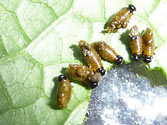



![Garden Insect Pests: Winged Aphid [alate] - Click to enlarge Garden Insect Pests: Winged Aphid [alate]](photos/P1030331b-th.jpg)

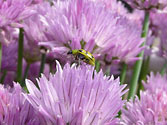
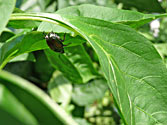

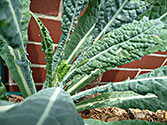
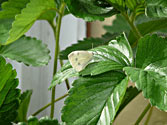
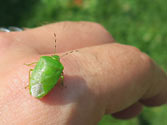
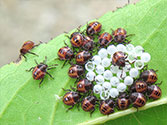
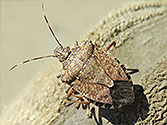
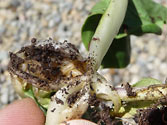


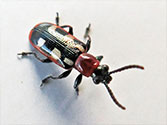
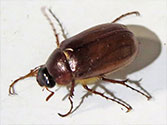
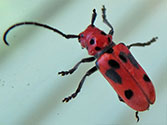



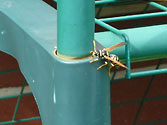
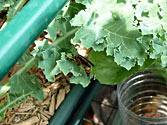
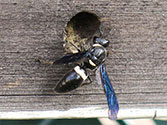

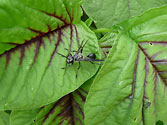
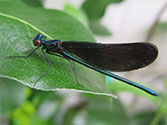

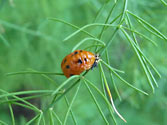

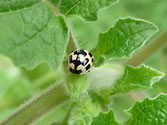
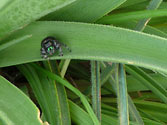
![Organic Garden Beneficial Insect: Yellow Garden Spider (Argiope aurantia) [Arachnid] - Click to enlarge Organic Garden Beneficial Insect: Yellow Garden Spider (Argiope aurantia) [Arachnid]](photos/yellow-garden-spider-argiope-aurantia-beneficial-insect-th.jpg)

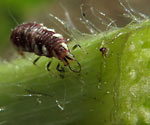

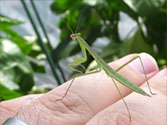
![Organic Garden Beneficial Insect: Wheel Bug (arilus cristatus) [Assassin Bug] - Click to enlarge Organic Garden Beneficial Insect: Wheel Bug (arilus cristatus) [Assassin Bug]](photos/IMG_0519b-th.jpg)
